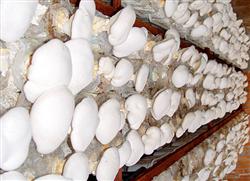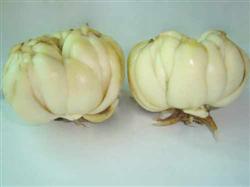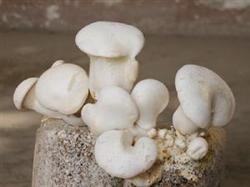Bag cultivation of Pleurotus ostreatus

Pleurotus nebrodensis, also known as white pleurotus ferulae, comes from ** and is also called Tianshan mushroom. It is a rare edible fungus with simple cultivation, tender quality and fresh taste, white color and high nutritional value. Pleurotus nebrodensis hyphae more dense than the general variety of white, strong resistance to impurities; fruiting bodies clustered or solitary, fleshy and plump, thick and long stalk, generally thick stalk 3-7 cm, 6-10 cm long, solid stalk, mushroom lid texture crisp and tender, mature when the top of the mushroom is rolled, generally 8-15 cm, single fresh weight 50-160 grams, up to 400 grams. Pleurotus nebrodensis belongs to moderate temperature mushroom fungi, mycelium can grow at 3-32℃, the best temperature is 24-27℃; fruiting temperature is 3-26℃, the fastest growth temperature is 12-22℃, the best quality can also grow slowly at about 0℃; the relative humidity of air in the fruiting period is 84-95%; both mycelium and fruiting body need fresh air for growth and development. When CO2 concentration exceeds 0.5%, abnormal mushrooms are easy to produce. Mycelium growth does not need light, fruiting body growth stage needs scattered light. The artificial cultivation techniques of Pleurotus nebrodensis are introduced as follows: 1. The production season is winter and spring, with high yield and best quality. In Gutian County, Fujian Province, sowing began in early September, mushroom began to grow in mid October, spring sowing could not exceed early February, harvest ended in early May. 2. The optimum culture medium for Pleurotus nebrodensis was high nitrogen. It grew well on the medium of cottonseed hull, sawdust, bagasse, straw, bran and corn (2345, 12.00, 0.51%) powder, and the conversion rate of two tide mushrooms reached 80-100%. Culture medium formula: ① cottonseed hull 40%, miscellaneous sawdust 40%, wheat bran 10%, corn flour 8%;② straw 57%, cottonseed hull 10%, sawdust 13%, wheat bran 10%, corn flour 8%;③ sawdust or cottonseed hull, bagasse 78%, wheat bran 12%, corn flour 8%. Each formula should add brown sugar, gypsum 1% each, water content control 65%. PH 6-7 is the best, when the temperature is high, 0.5% lime can be added to the material to prevent the culture material from swelling. Cultures were prepared as usual. 3. The bag cultivation method is suitable for inoculation of mushroom. sterilize at 100 deg. c for 16 h, cooling to 25 deg. c, open that tie or plug to inoculate Pleurotus nebrodensis strain under aseptic condition. Hair bacteria culture temperature 25-28℃, air humidity 70% below, frequent ventilation. Avoid strong light during bag cultivation. 4. fruiting management: after 30-40 days of culturing hyphae, the bag can be full of growth. when the primordium appears on the material surface or side surface, the cultivation bag reaching physiological maturity is moved to the fruiting shed to grow mushrooms. After the mushroom bag is moved into the mushroom shed, open the bag mouth. The temperature is controlled at 10-23℃, and the primordium appears in about 7 days. When the cap grows to 2 cm, increase the amount of water sprayed and strengthen ventilation. In the early stage, the relative humidity of the space can be maintained at 80%, and the light can be controlled in the later stage. After opening the bag, the sterilized vegetable garden soil can be used to cover the bag with 2-3 cm of soil. 5. Harvesting and processing Pleurotus nebrodensis can be harvested from primordium appearance to fruiting body maturity 8-12. Stop spraying water after harvest and clean up the surroundings of bag mouth and environment. Let the mycelium live and grow. After 5 days, water spraying and temperature control were continued. Generally can receive 2 tide mushroom. Fresh products directly listed or salted; can also be sliced into dried products for export processing.
- Prev

High-yield cultivation techniques of Edible Lily
Lily is a cross-year crop. After planting in the autumn of the first year, it will not be able to break the soil and show seedlings until the following spring, during which it has been bred and grown in the ground for nearly half a year. In order to obtain high yield, the following technical links should be grasped in cultivation: first, the selection of suitable improved varieties of lilies can be divided into edible and medicinal varieties, with a total of more than 10 varieties. Eat.
- Next

Causes and Preventive measures of abnormal Pleurotus ostreatus
1. The structure of the shed is unreasonable. The cultivation site of Pleurotus ostreatus is divided into indoor mushroom room and field mushroom shed. Often due to unreasonable design, resulting in poor air circulation, serious hypoxia, resulting in deformities of Pleurotus ostreatus. The ideal mushroom shed should sit north to south or west to east. The shed should not be too large, and the general rectangular shed can hold 300.
Related
- Fuxing push coffee new agricultural production and marketing class: lack of small-scale processing plants
- Jujube rice field leisure farm deep ploughing Yilan for five years to create a space for organic food and play
- Nongyu Farm-A trial of organic papaya for brave women with advanced technology
- Four points for attention in the prevention and control of diseases and insect pests of edible fungi
- How to add nutrient solution to Edible Fungi
- Is there any good way to control edible fungus mites?
- Open Inoculation Technology of Edible Fungi
- Is there any clever way to use fertilizer for edible fungus in winter?
- What agents are used to kill the pathogens of edible fungi in the mushroom shed?
- Rapid drying of Edible Fungi

